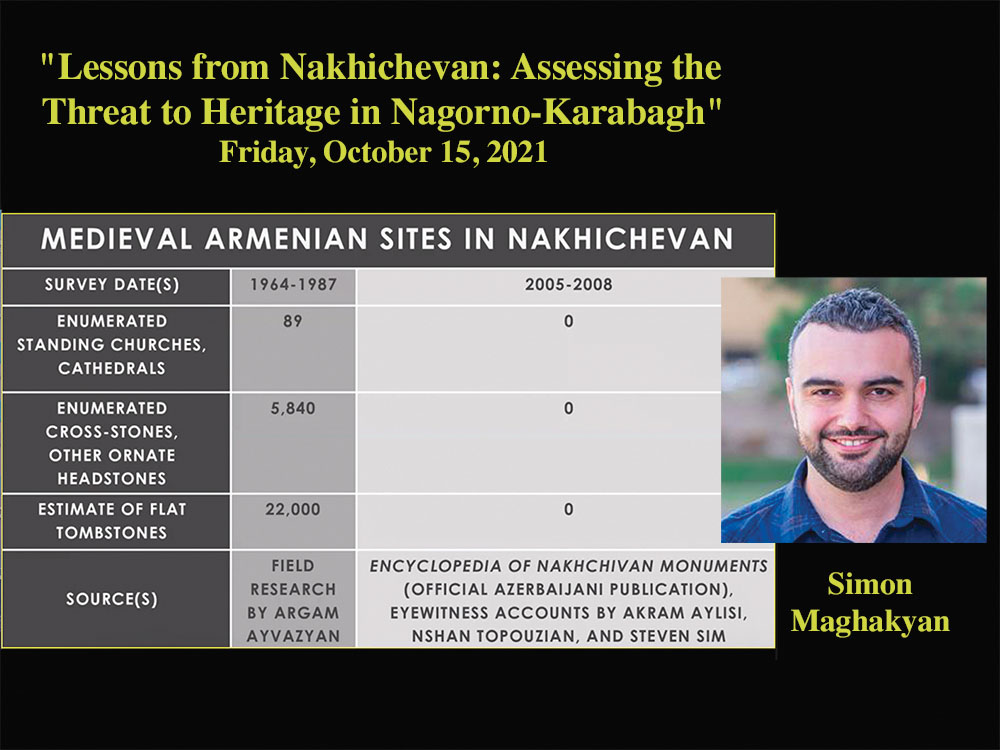 Sara Beberian
Sara Beberian
Staff Writer
For Armenians, experiencing threats to their culture and heritage is not uncommon. For centuries, Armenians have had to fight to protect their land, monuments, culture, and religion. Even though things should be different in 2021, Armenians are still forced to do this every day. The recent 2020 war between Armenia and Azerbaijan, reflects an Armenian people who have had to stand up and protect what has been theirs for centuries. This does not mean fighting as just a soldier – everyday people can help by protecting Armenian monuments, churches, cemeteries, and important artifacts from destruction. These monuments are centuries old and are a vital part of Armenian culture and heritage – physical evidence of how Armenians are a productive and ancient people.
Simon Maghakyan is an outspoken advocate for the preservation of these important Armenian monuments. He joined the Fresno State community via Zoom on Thursday, October 21 to present a lecture entitled “Lessons From Nakhichevan: Assessing the Threat to Heritage in Nagorno Karabagh” for the ASP Fall Lecture Series.
Maghakyan is a political scientist, a Ph.D. student, as well as an investigative researcher working from Denver, Colorado. He is very involved in human rights advocacy, especially when it comes to Armenian issues. He speaks on behalf of Armenians in many ways and is currently serving as Amnesty International USA’s primary specialist and campaigner for the former USSR republics.
Maghakyan recently spoke at the International Religious Freedom and Peace Conference, in Holy Etchmiadzin, on preventing cultural genocide in Artsakh through religious freedom.
Maghakyan also manages an important informational website: savearmenianmonuments.com, which highlights Armenian sacred sites.
Maghakyan started his presentation by giving a brief history of Armenia and Azerbaijan. Azerbaijan is taking part in a literal “cancel culture” against Armenians by destroying sacred sites and monuments in areas of Artsakh which were occupied as a result of the 2020 war.
Maghakyan tracks the monuments that are being demolished or damaged using geo-spatial data, eyewitness testimony, and visual crowdsourcing. Azerbaijan denies that they are destroying monuments and at the same time their government passes legislation demanding the removal of Armenian monuments. Maghakyan noted that, “we are not talking about individuals or communities engaged in vandalism… we are talking about a state apparatus engaging and deploying its military and its resources to wipe out a culture.” This is a deliberate and state-sponsored cultural genocide followed by denial and cover-ups. The best example of this, and the most disheartening for Armenians, is the story of the Djulfa cemetery khatchkars (stone-crosses), once the world’s largest collection of Armenian khatchkars, before it was destroyed by Azerbaijan in 2005.
The Azerbaijani government is motivated to destroy Armenian culture for different reasons. Maghakyan reports the most obvious: the Azerbaijan wants to complete the final erasure of Armenians, and that includes erasing its history. Other reasons include wanting to demonstrate their own legitimacy and power, and pulling ahead in their competition with Turkey to see who can do the most damage to the Armenian people. Armenians are fighting an uphill battle when it comes to the preservation of their culture.
The best way to make sure that Armenian sacred sites are preserved is to visit them. “The targeted group has agency in this process – individuals and communities can play a role in the preservation and in peace,” stated Maghakyan. It could become easy, especially when it seems difficult, to just give up in trying to preserve Armenian culture, but this is exactly the opposite of what we should do. As individuals, it is important to do what we can to preserve Armenian culture as a whole.
“The easiest thing to do is to expect the state and international organizations to address these concerns but it is important to come back to the question of what individuals and communities can do,” stated Maghakyan. “It is so easy to sit back and criticize… instead, proactively do something to help protect the monuments.” What will you do?
 Hye Sharzhoom Armenian Action
Hye Sharzhoom Armenian Action